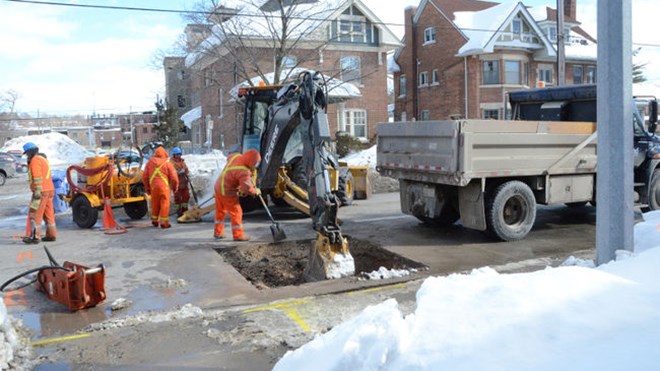Aging city infrastructure is at least part of the reason why the number of insurance claims against Greater Sudbury have more than doubled since 2011, setting a new record in 2014 alone.
Robert Walz, city's co-ordinator of insurance and risk management, told members of the finance committee Tuesday there were 676 claims last year, compared to 326 three years earlier. And as of April of this year, there already have been 192 claims.
In dollar terms, paying insurance premiums and handling all those claims cost taxpayers $4,322,598 last year, a figure that includes $472,861 paid to those who made successful claims.
The largest number of claims are related to potholes – 210 last year alone – but Walz said only about two per cent are successful. That's because the city is only liable under some very specific conditions.
“The city is not responsible if someone drives into a pothole,” he said.
More alarming, he said, is the soaring number of claims related to sewer backups. That's largely a result of insurance companies across Canada raising premiums and limiting coverage in an effort to stem their costs.
Those claims are more complicated because the city is responsible if the blockage is on public property. If the problem is on the homeowner’s land, they are responsible.
In 2011, there were 43 such claims filed against the city; in 2014, that number increased to 161. Also on the rise are claims related to property damage, which have gone up from 31 in 2011 to 152 last year.
Those claims include damage to vehicles from road conditions, damages from sanding and snowplow operations and construction, by both city and contract employees.
“Weather plays a role in the increase of claims,” said a report on the current state of the city's insurance situation.
To address the issues and reduce the city's exposure to lawsuits, Walz said they are in the process of creating a map of the city that will include where the claims originated. That way they can look for trouble spots where staff can focus efforts to minimize risk – and reduce the number of claims.
New software has allowed them to greatly reduce the amount of time spent handling claims – down from 40-50 hours to just an hour or two, Walz said. And staff are being encouraged to come forward and be honest about what happened when the city is being sued, he said, which happens about 20-24 times a year.
“It's not about blaming someone,” he said. “We'd rather know immediately if there's been negligence.”
If they are at fault, it's much cheaper and fairer to all involved if they find out right away, he said, rather than after “three years in court.”
He also praised lawyers in Sudbury, calling them professional and good to deal with when coming to a settlement.
“It's a great group of professional lawyers we have in Sudbury,” he said.
There was some good news on the insurance front. By taking the process in-house and not using an insurance broker, the city was able to reduce the amount it spends on insuring its $1.2 billion in assets spread out across 700 properties.
They also reclassified some of those properties that had been declared vacant (which are three times more expensive to insure) by using them for storage and setting up remote monitoring.
All told, their premiums went down by more than $250,000 in 2015 compared to a year earlier, and now total $2,665,169.
“We're very proud of that,” Walz said.
Join Sudbury.com+
- Messages
- Post a Listing
- Your Listings
- Your Profile
- Your Subscriptions
- Your Likes
- Your Business
- Support Local News
- Payment History
Sudbury.com+ members
Already a +member?
Not a +member?
Sign up for a Sudbury.com+ account for instant access to upcoming contests, local offers, auctions and so much more.
